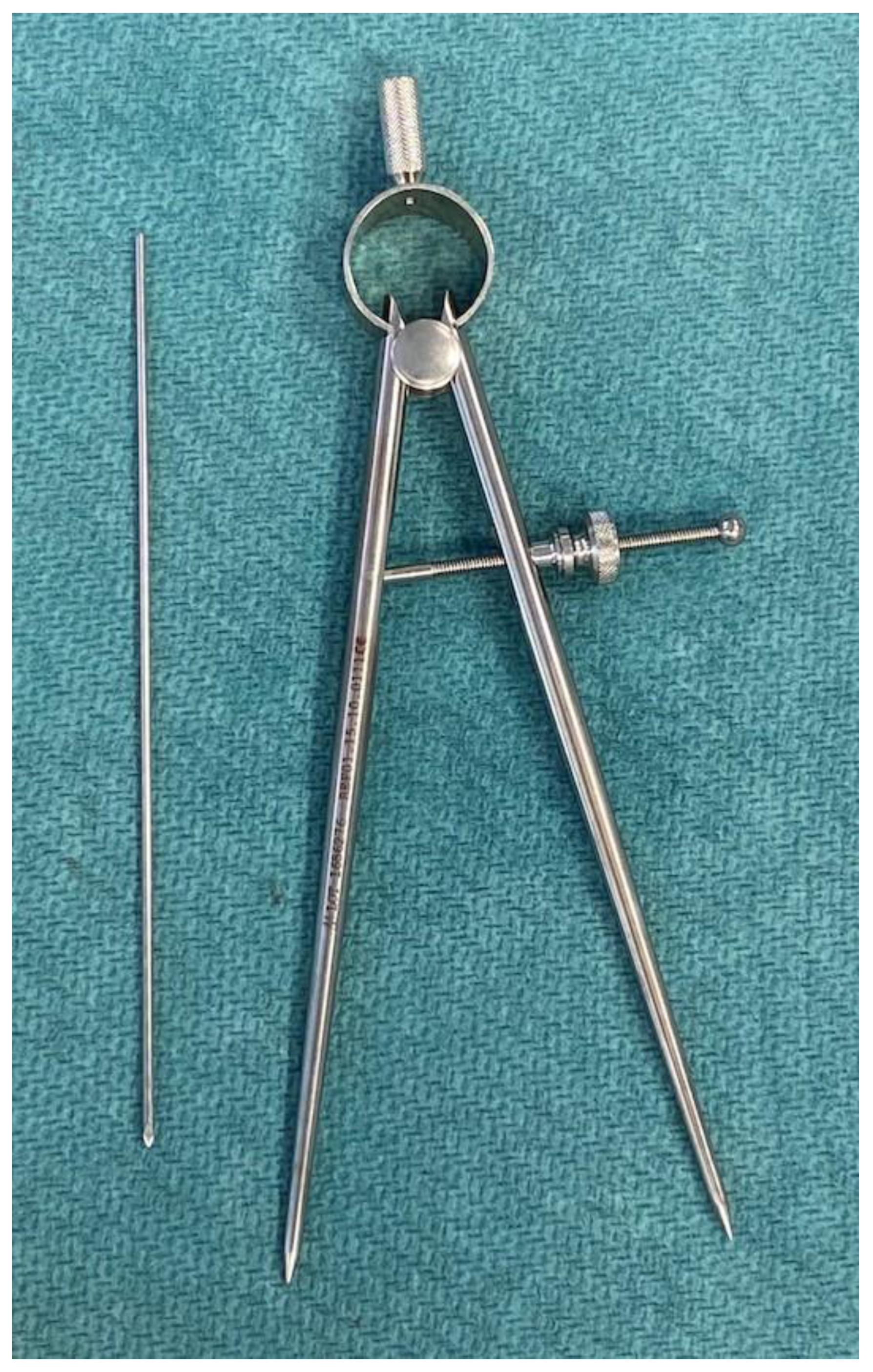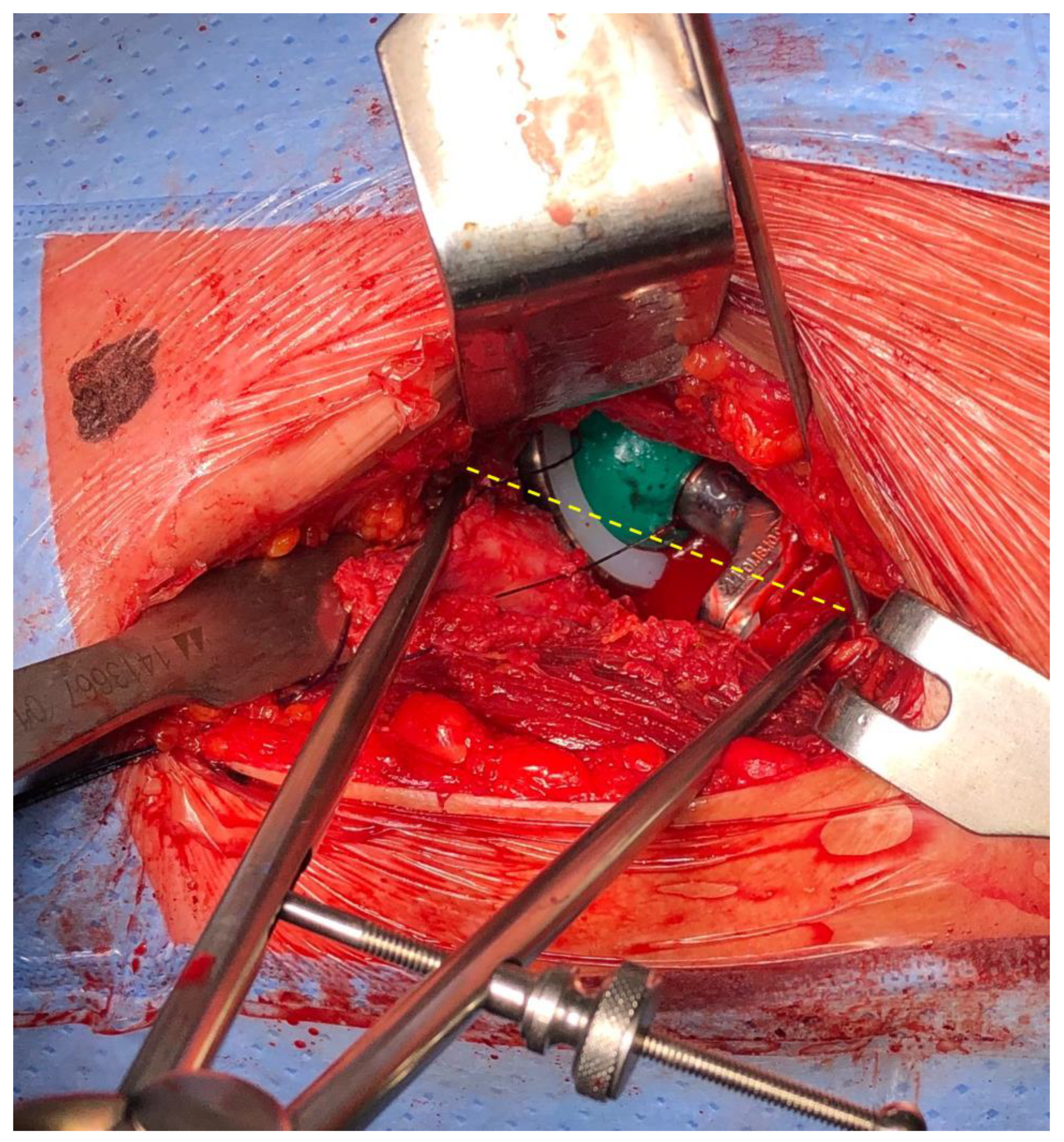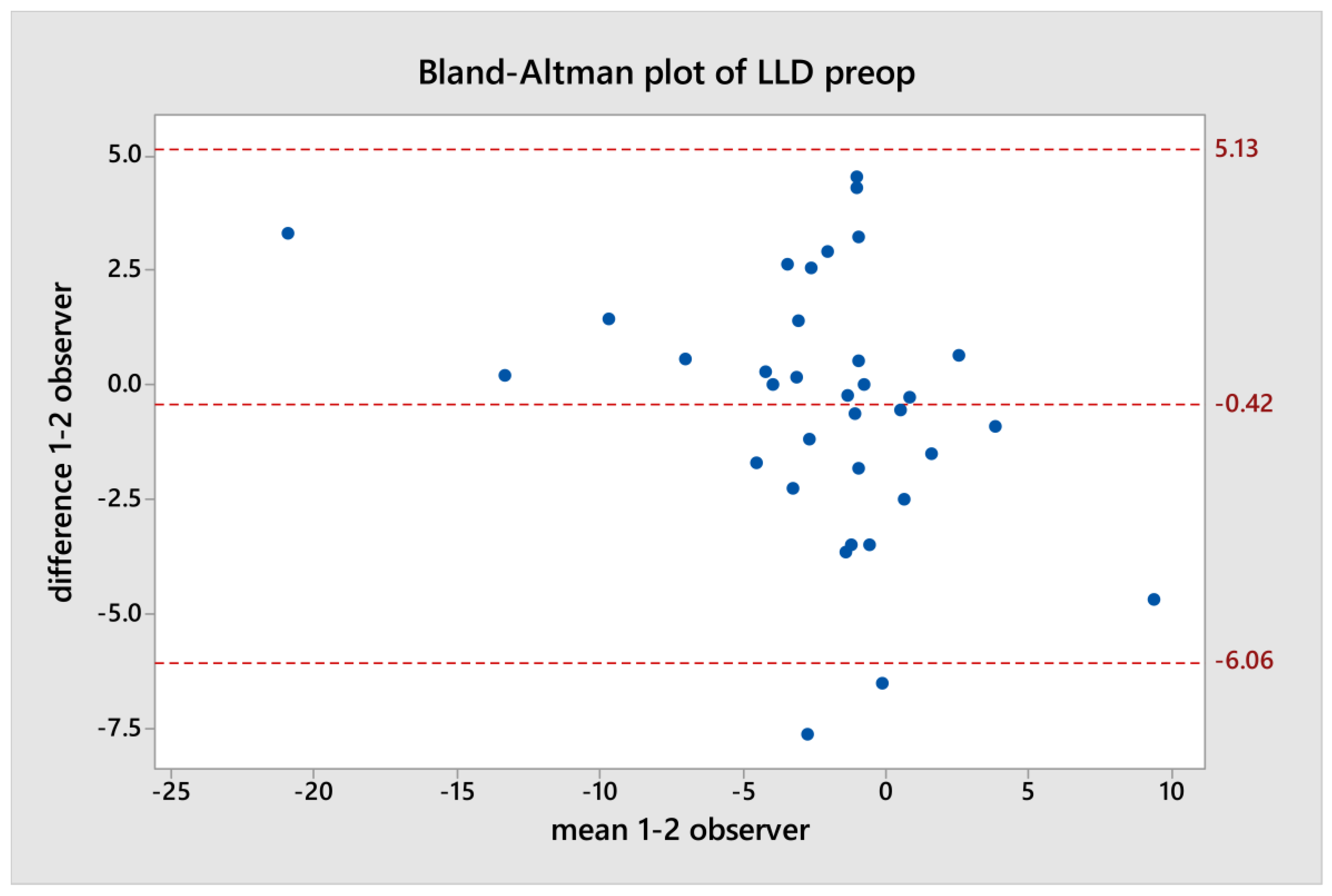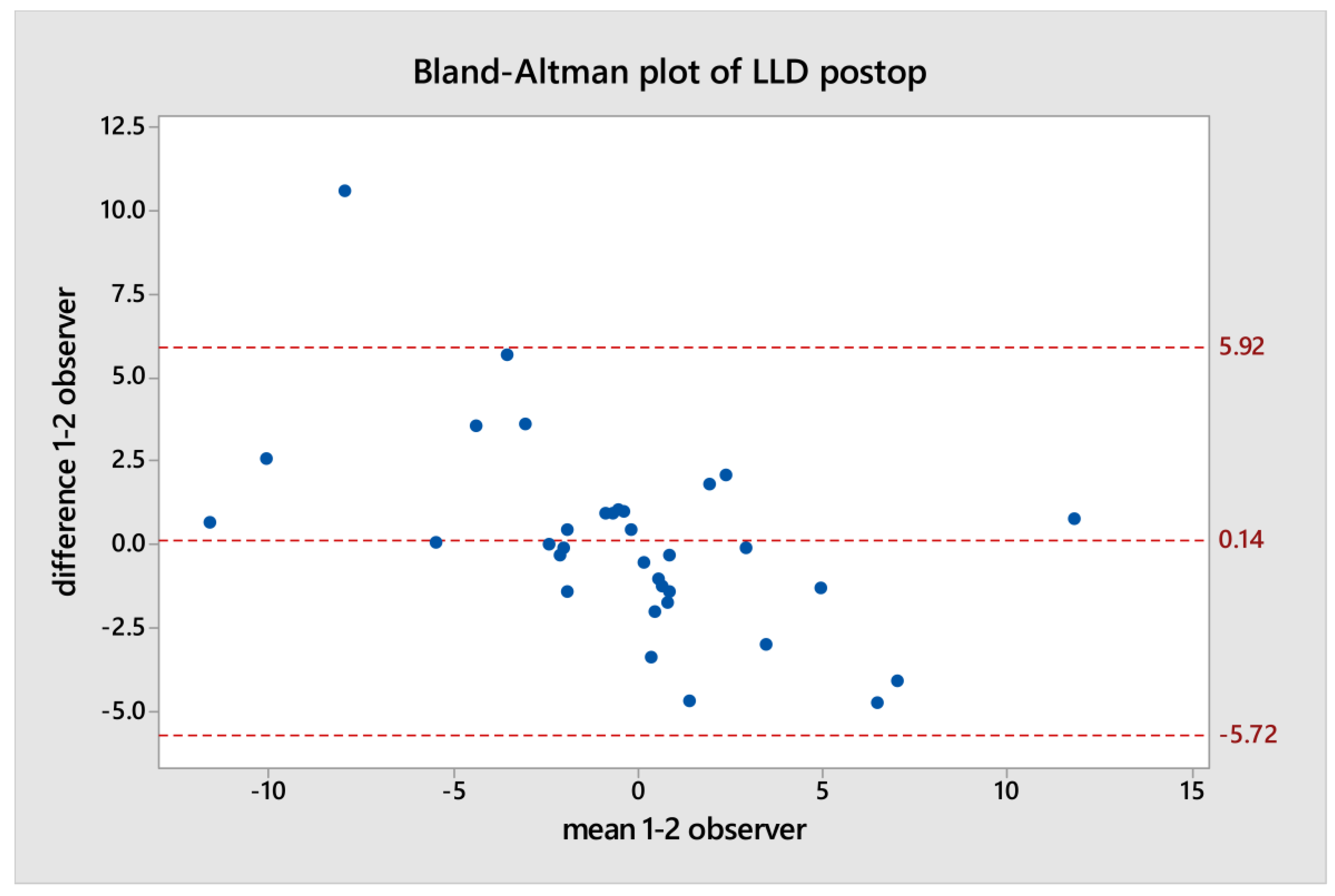An Intraoperative Method to Minimize Leg Length Discrepancy in Anterior Minimally Invasive Total Hip Arthroplasty—A Prospective Study
Abstract
1. Introduction
2. Materials and Methods
2.1. Patients Population
2.2. Compass Device
2.3. Surgical Technique
2.4. Radiographic Measurements
3. Results
4. Discussion
5. Conclusions
Author Contributions
Funding
Institutional Review Board Statement
Informed Consent Statement
Data Availability Statement
Acknowledgments
Conflicts of Interest
References
- Enke, O.; Levy, Y.D.; Bruce, W.J. Accuracy of Leg Length and Femoral Offset Restoration after Total Hip Arthroplasty with the Utilisation of an Intraoperative Calibration Gauge. Hip Int. J. Clin. Exp. Res. Hip Pathol. Ther. 2020, 30, 296–302. [Google Scholar] [CrossRef] [PubMed]
- Gheewala, R.A.; Young, J.R.; Villacres Mori, B.; Lakra, A.; DiCaprio, M.R. Perioperative Management of Leg-Length Discrepancy in Total Hip Arthroplasty: A Review. Arch. Orthop. Trauma Surg. 2023, 143, 5417–5423. [Google Scholar] [CrossRef]
- Flecher, X.; Ollivier, M.; Argenson, J.N. Lower Limb Length and Offset in Total Hip Arthroplasty. Orthop. Traumatol. Surg. Res. 2016, 102, S9–S20. [Google Scholar] [CrossRef] [PubMed]
- Iwakiri, K.; Ohta, Y.; Fujii, T.; Minoda, Y.; Kobayashi, A.; Nakamura, H. Changes in Patient-Perceived Leg Length Discrepancy Following Total Hip Arthroplasty. Eur. J. Orthop. Surg. Traumatol. 2021, 31, 1355–1361. [Google Scholar] [CrossRef] [PubMed]
- Chen, G.; Nie, Y.; Xie, J.; Cao, G.; Huang, Q.; Pei, F. Gait Analysis of Leg Length Discrepancy-Differentiated Hip Replacement Patients With Developmental Dysplasia: A Midterm Follow-Up. J. Arthroplasty 2018, 33, 1437–1441. [Google Scholar] [CrossRef] [PubMed]
- Gupta, R.; Pathak, P.; Singh, R.; Majumdar, K.P. Double-Stitch Technique: A Simple and Effective Method to Minimize Limb Length Discrepancy after Total Hip Arthroplasty. Indian J. Orthop. 2019, 53, 169–173. [Google Scholar] [CrossRef] [PubMed]
- Patterson, D.C.; Grelsamer, R.P.; Bronson, M.J.; Moucha, C.S. Lawsuits After Primary and Revision Total Hip Arthroplasties: A Malpractice Claims Analysis. J. Arthroplasty 2017, 32, 2958–2962. [Google Scholar] [CrossRef] [PubMed]
- Rougereau, G.; Marty-Diloy, T.; Langlais, T.; Pujol, N.; Boisrenoult, P. Litigation after Primary Total Hip and Knee Arthroplasties in France: Review of Legal Actions over the Past 30 Years. Arch. Orthop. Trauma Surg. 2022, 142, 3505–3513. [Google Scholar] [CrossRef] [PubMed]
- Cunningham, D.J.; Ryan, S.P.; Hong, C.; Mithani, S.K.; Adams, S.B. Incidence and Risk Factors for Flap Coverage after Total Ankle Arthroplasty. Foot Ankle Int. 2021, 42, 744–749. [Google Scholar] [CrossRef]
- Ranawat, C.S.; Rao, R.R.; Rodriguez, J.A.; Bhende, H.S. Correction of Limb-Length Inequality during Total Hip Arthroplasty. J. Arthroplasty 2001, 16, 715–720. [Google Scholar] [CrossRef]
- McGee, H.M.; Scott, J.H. A Simple Method of Obtaining Equal Leg Length in Total Hip Arthroplasty. Clin. Orthop. Relat. Res. 1985, 194, 269–270. [Google Scholar] [CrossRef] [PubMed]
- Huddleston, H.D. An Accurate Method for Measuring Leg Length and Hip Offset in Hip Arthroplasty. Orthopedics 1997, 20, 331–332. [Google Scholar] [CrossRef] [PubMed]
- Jasty, M.; Webster, W.; Harris, W. Management of Limb Length Inequality during Total Hip Replacement. Clin. Orthop. Relat. Res. 1996, 333, 165–171. [Google Scholar] [CrossRef]
- Naito, M.; Ogata, K.; Asayama, I. Intraoperative Limb Length Measurement in Total Hip Arthroplasty. Int. Orthop. 1999, 23, 31–33. [Google Scholar] [CrossRef] [PubMed]
- Bose, W.J. Accurate Limb-Length Equalization during Total Hip Arthroplasty. Orthopedics 2000, 23, 433–436. [Google Scholar] [PubMed]
- Shiramizu, K.; Naito, M.; Shitama, T.; Nakamura, Y.; Shitama, H. L-Shaped Caliper for Limb Length Measurement during Total Hip Arthroplasty. J. Bone Jt. Surg. Br. 2004, 86, 966–969. [Google Scholar] [CrossRef]
- Sarin, V.K.; Pratt, W.R.; Bradley, G.W. Accurate Femur Repositioning Is Critical during Intraoperative Total Hip Arthroplasty Length and Offset Assessment. J. Arthroplasty 2005, 20, 887–891. [Google Scholar] [CrossRef] [PubMed]
- Kezer, M.; Kizilay, Y.O. A Novel Approach for Correcting Limb Length Discrepancy in Total Hip Arthroplasty. Cureus 2024, 16, e56628. [Google Scholar] [CrossRef] [PubMed]
- Nossa, J.M.; Muñoz, J.M.; Riveros, E.A.; Rueda, G.; Márquez, D.; Pérez, J. Leg Length Discrepancy after Total Hip Arthroplasty: Comparison of 3 Intraoperative Measurement Methods. Hip Int. J. Clin. Exp. Res. Hip Pathol. Ther. 2018, 28, 254–258. [Google Scholar] [CrossRef]
- Faldini, C. Leg Length Discrepancy after Primary Total Hip Replacement. Musculoskelet. Surg. 2023, 107, 1–5. [Google Scholar] [CrossRef]
- Laude, F. Total Hip Arthroplasty through an Anterior Hueter Minimally Invasive Approach. Interact. Surg. 2006, 1, 5–11. [Google Scholar] [CrossRef]
- Woolson, S.T.; Hartford, J.M.; Sawyer, A. Results of a Method of Leg-Length Equalization for Patients Undergoing Primary Total Hip Replacement. J. Arthroplasty 1999, 14, 159–164. [Google Scholar] [CrossRef] [PubMed]
- Haghayegh, S.; Kang, H.-A.; Khoshnevis, S.; Smolensky, M.H.; Diller, K.R. A Comprehensive Guideline for Bland-Altman and Intra Class Correlation Calculations to Properly Compare Two Methods of Measurement and Interpret Findings. Physiol. Meas. 2020, 41, 55012. [Google Scholar] [CrossRef] [PubMed]
- O’Brien, S.; Kernohan, G.; Fitzpatrick, C.; Hill, J.; Beverland, D. Perception of Imposed Leg Length Inequality in Normal Subjects. Hip Int. J. Clin. Exp. Res. Hip Pathol. Ther. 2010, 20, 505–511. [Google Scholar] [CrossRef] [PubMed]
- Kucukdurmaz, F.; Sukeik, M.; Parvizi, J. A Meta-Analysis Comparing the Direct Anterior with Other Approaches in Primary Total Hip Arthroplasty. Surgeon 2019, 17, 291–299. [Google Scholar] [CrossRef]
- Loh, B.; Padki, A.; Yew, A.; Pang, H.N. Functional Outcome of Direct Anterior versus Posterior Approach in Total Hip Arthroplasty: A Propensity-Matched Asian Study. Singapore Med. J. 2024. [Google Scholar] [CrossRef]
- Jia, F.; Guo, B.; Xu, F.; Hou, Y.; Tang, X.; Huang, L. A Comparison of Clinical, Radiographic and Surgical Outcomes of Total Hip Arthroplasty between Direct Anterior and Posterior Approaches: A Systematic Review and Meta-Analysis. Hip Int. J. Clin. Exp. Res. Hip Pathol. Ther. 2019, 29, 584–596. [Google Scholar] [CrossRef] [PubMed]
- Ang, J.J.M.; Onggo, J.R.; Stokes, C.M.; Ambikaipalan, A. Comparing Direct Anterior Approach versus Posterior Approach or Lateral Approach in Total Hip Arthroplasty: A Systematic Review and Meta-Analysis. Eur. J. Orthop. Surg. Traumatol. 2023, 33, 2773–2792. [Google Scholar] [CrossRef] [PubMed]
- Sebečić, B.; Starešinić, M.; Culjak, V.; Japjec, M. Minimally Invasive Hip Arthroplasty: Advantages and Disadvantages. Med. Glas. Off. Publ. Med. Assoc. Zenica-Doboj Canton Bosnia Herzegovina 2012, 9, 160–165. [Google Scholar]
- den Hartog, Y.M.; Mathijssen, N.M.C.; Vehmeijer, S.B.W. The Less Invasive Anterior Approach for Total Hip Arthroplasty: A Comparison to Other Approaches and an Evaluation of the Learning Curve—A Systematic Review. Hip Int. J. Clin. Exp. Res. Hip Pathol. Ther. 2016, 26, 105–120. [Google Scholar] [CrossRef]
- Brun, O.-C.L.; Sund, H.N.; Nordsletten, L.; Röhrl, S.M.; Mjaaland, K.E. Component Placement in Direct Lateral vs Minimally Invasive Anterior Approach in Total Hip Arthroplasty: Radiographic Outcomes From a Prospective Randomized Controlled Trial. J. Arthroplasty 2019, 34, 1718–1722. [Google Scholar] [CrossRef]
- Luger, M.; Hochgatterer, R.; Klotz, M.C.; Allerstorfer, J.; Gotterbarm, T.; Schauer, B. A Single-Surgeon Experience in Reconstruction of Femoro-Acetabular Offset and Implant Positioning in Direct Anterior Approach and Anterolateral MIS Approach with a Curved Short Stem. Arch. Orthop. Trauma Surg. 2022, 142, 871–878. [Google Scholar] [CrossRef]
- Müller, D.A.; Zingg, P.O.; Dora, C. Anterior Minimally Invasive Approach for Total Hip Replacement: Five-Year Survivorship and Learning Curve. Hip Int. J. Clin. Exp. Res. Hip Pathol. Ther. 2014, 24, 277–283. [Google Scholar] [CrossRef]
- Macheras, G.A.; Christofilopoulos, P.; Lepetsos, P.; Leonidou, A.O.; Anastasopoulos, P.P.; Galanakos, S.P. Nerve Injuries in Total Hip Arthroplasty with a Mini Invasive Anterior Approach. Hip Int. J. Clin. Exp. Res. Hip Pathol. Ther. 2016, 26, 338–343. [Google Scholar] [CrossRef]
- Berndt, K.; Rahm, S.; Dora, C.; Zingg, P.O. Total Hip Arthroplasty with Accolade/Trident through the Direct Minimally Invasive Anterior Approach without Traction Table: Learning Curve and Results after a Minimum of 5 Years. Orthop. Traumatol. Surg. Res. 2019, 105, 931–936. [Google Scholar] [CrossRef]
- Vigdorchik, J.M.; Sharma, A.K.; Jerabek, S.A.; Mayman, D.J.; Sculco, P.K. Templating for Total Hip Arthroplasty in the Modern Age. J. Am. Acad. Orthop. Surg. 2021, 29, e208–e216. [Google Scholar] [CrossRef]
- Mainard, D.; Barbier, O.; Knafo, Y.; Belleville, R.; Mainard-Simard, L.; Gross, J.-B. Accuracy and Reproducibility of Preoperative Three-Dimensional Planning for Total Hip Arthroplasty Using Biplanar Low-Dose Radiographs: A Pilot Study. Orthop. Traumatol. Surg. Res. 2017, 103, 531–536. [Google Scholar] [CrossRef]
- Lim, Y.W.; Chang, Y.J.; Kwon, S.Y.; Kim, Y.S. A Simple Method Using a PACS to Minimize Leg Length Discrepancy in Primary THA: A Method to Minimize Leg Length Discrepancy. J. Arthroplasty 2013, 28, 1791–1795. [Google Scholar] [CrossRef]
- Pongkunakorn, A.; Udomluck, P.; Aksornthung, C.; Wangjiraphan, N. Digital Templating of THA Using PACS and an IPhone or IPad Is as Accurate as Commercial Digital Templating Software. Clin. Orthop. Relat. Res. 2023, 481, 1104–1113. [Google Scholar] [CrossRef]
- Fowler, J.R.; Ilyas, A.M. The Accuracy of Digital Radiography in Orthopaedic Applications. Clin. Orthop. Relat. Res. 2011, 469, 1781–1784. [Google Scholar] [CrossRef]
- Williamson, J.A.; Reckling, F.W. Limb Length Discrepancy and Related Problems Following Total Hip Joint Replacement. Clin. Orthop. Relat. Res. 1978, 134, 135–138. [Google Scholar] [CrossRef]
- Meermans, G.; Malik, A.; Witt, J.; Haddad, F. Preoperative Radiographic Assessment of Limb-Length Discrepancy in Total Hip Arthroplasty. Clin. Orthop. Relat. Res. 2011, 469, 1677–1682. [Google Scholar] [CrossRef]
- Guo, R.; Chen, J.Y.; Zhang, G.; Zhou, Y.; Chen, J.; Chai, W. Calculation Method to Predict Postoperative Limb Length in Patients Undergoing THA Following Developmental Dysplasia of Hips. BMC Musculoskelet. Disord. 2019, 20, 513. [Google Scholar] [CrossRef]
- Lecoanet, P.; Vargas, M.; Pallaro, J.; Thelen, T.; Ribes, C.; Fabre, T. Leg Length Discrepancy after Total Hip Arthroplasty: Can Leg Length Be Satisfactorily Controlled via Anterior Approach without a Traction Table? Evaluation in 56 Patients with EOS 3D. Orthop. Traumatol. Surg. Res. 2018, 104, 1143–1148. [Google Scholar] [CrossRef]
- Takao, M.; Nishii, T.; Sakai, T.; Sugano, N. Postoperative Limb-Offset Discrepancy Notably Affects Soft-Tissue Tension in Total Hip Arthroplasty. J. Bone Jt. Surg. Am. 2016, 98, 1548–1554. [Google Scholar] [CrossRef]
- Ji, W.; Stewart, N. Fluoroscopy Assessment during Anterior Minimally Invasive Hip Replacement Is More Accurate than with the Posterior Approach. Int. Orthop. 2016, 40, 21–27. [Google Scholar] [CrossRef]
- Bingham, J.S.; Spangehl, M.J.; Hines, J.T.; Taunton, M.J.; Schwartz, A.J. Does Intraoperative Fluoroscopy Improve Limb-Length Discrepancy and Acetabular Component Positioning During Direct Anterior Total Hip Arthroplasty? J. Arthroplast. 2018, 33, 2927–2931. [Google Scholar] [CrossRef]
- Nam, D.; Sculco, P.K.; Abdel, M.P.; Alexiades, M.M.; Figgie, M.P.; Mayman, D.J. Leg-Length Inequalities Following THA Based on Surgical Technique. Orthopedics 2013, 36, e395–e400. [Google Scholar] [CrossRef]
- Matta, J.M.; Shahrdar, C.; Ferguson, T. Single-Incision Anterior Approach for Total Hip Arthroplasty on an Orthopaedic Table. Clin. Orthop. Relat. Res. 2005, 441, 115–124. [Google Scholar] [CrossRef]
- Austin, D.C.; Dempsey, B.E.; Kunkel, S.T.; Torchia, M.T.; Jevsevar, D.S. A Comparison of Radiographic Leg-Length and Offset Discrepancies between 2 Intraoperative Measurement Techniques in Anterior Total Hip Arthroplasty. Arthroplast. Today 2019, 5, 181–186. [Google Scholar] [CrossRef]
- Bradley, M.P.; Benson, J.R.; Muir, J.M. Accuracy of Acetabular Component Positioning Using Computer-Assisted Navigation in Direct Anterior Total Hip Arthroplasty. Cureus 2019, 11, e4478. [Google Scholar] [CrossRef]
- Rajpaul, J.; Rasool, M.N. Leg Length Correction in Computer Assisted Primary Total Hip Arthroplasty: A Collective Review of the Literature. J. Orthop. 2018, 15, 442–446. [Google Scholar] [CrossRef]
- Ellapparadja, P.; Mahajan, V.; Atiya, S.; Sankar, B.; Deep, K. Leg Length Discrepancy in Computer Navigated Total Hip Arthroplasty—How Accurate Are We? Hip Int. J. Clin. Exp. Res. Hip Pathol. Ther. 2016, 26, 438–443. [Google Scholar] [CrossRef]
- Laggner, R.; Oktarina, A.; Windhager, R.; Bostrom, M.P.G. Changes in Leg Length and Hip Offset in Navigated Imageless vs. Conventional Total Hip Arthroplasty. Sci. Rep. 2023, 13, 17161. [Google Scholar] [CrossRef]
- Dundon, J.M.; Mays, R.R. Revising Substantial Leg Length Discrepancy in Total Hip Arthroplasty Using Computer-Assisted Navigated Systems: A Case Series of Three Patients. Cureus 2019, 11, e5137. [Google Scholar] [CrossRef]
- Hecht, C.J., 2nd; Nedder, V.J.; Porto, J.R.; Morgan, K.A.; Kamath, A.F. Are Robotic-Assisted and Computer-Navigated Total Hip Arthroplasty Associated with Superior Outcomes in Patients Who Have Hip Dysplasia? J. Orthop. 2024, 53, 125–132. [Google Scholar] [CrossRef]
- Mihalko, W.M.; Phillips, M.J.; Krackow, K.A. Acute Sciatic and Femoral Neuritis Following Total Hip Arthroplasty. A Case Report. J. Bone Jt. Surg. Am. 2001, 83, 589–592. [Google Scholar] [CrossRef]
- Matsuda, K.; Nakamura, S.; Matsushita, T. A Simple Method to Minimize Limb-Length Discrepancy after Hip Arthroplasty. Acta Orthop. 2006, 77, 375–379. [Google Scholar] [CrossRef]
- Takigami, I.; Itokazu, M.; Itoh, Y.; Matsumoto, K.; Yamamoto, T.; Shimizu, K. Limb-Length Measurement in Total Hip Arthroplasty Using a Calipers Dual Pin Retractor. Bull. NYU Hosp. Jt. Dis. 2008, 66, 107–110. [Google Scholar]
- Sariali, E.; Mauprivez, R.; Khiami, F.; Pascal-Mousselard, H.; Catonné, Y. Accuracy of the Preoperative Planning for Cementless Total Hip Arthroplasty. A Randomised Comparison between Three-Dimensional Computerised Planning and Conventional Templating. Orthop. Traumatol. Surg. Res. 2012, 98, 151–158. [Google Scholar] [CrossRef]
- Sykes, A.; Hill, J.; Orr, J.; Humphreys, P.; Rooney, A.; Morrow, E.; Beverland, D. Patients’ Perception of Leg Length Discrepancy Post Total Hip Arthroplasty. Hip Int. J. Clin. Exp. Res. Hip Pathol. Ther. 2015, 25, 452–456. [Google Scholar] [CrossRef]
- Knafo, Y.; Houfani, F.; Zaharia, B.; Egrise, F.; Clerc-Urmès, I.; Mainard, D. Value of 3D Preoperative Planning for Primary Total Hip Arthroplasty Based on Biplanar Weightbearing Radiographs. Biomed Res. Int. 2019, 2019, 1932191. [Google Scholar] [CrossRef]
- Mancino, F.; Fontalis, A.; Magan, A.; Plastow, R.; Haddad, F.S. The Value of Computed Tomography Scan in Three-Dimensional Planning and Intraoperative Navigation in Primary Total Hip Arthroplasty. Hip Pelvis 2024, 36, 26–36. [Google Scholar] [CrossRef]
- Moralidou, M.; Di Laura, A.; Henckel, J.; Hothi, H.; Hart, A.J. Three-Dimensional Pre-Operative Planning of Primary Hip Arthroplasty: A Systematic Literature Review. EFORT Open Rev. 2020, 5, 845–855. [Google Scholar] [CrossRef]







Disclaimer/Publisher’s Note: The statements, opinions and data contained in all publications are solely those of the individual author(s) and contributor(s) and not of MDPI and/or the editor(s). MDPI and/or the editor(s) disclaim responsibility for any injury to people or property resulting from any ideas, methods, instructions or products referred to in the content. |
© 2024 by the authors. Licensee MDPI, Basel, Switzerland. This article is an open access article distributed under the terms and conditions of the Creative Commons Attribution (CC BY) license (https://creativecommons.org/licenses/by/4.0/).
Share and Cite
Girolami, M.; Bevoni, R.; Artioli, E.; Beluzzi, R.; Vasco, C.; Caravelli, S.; Baiardi, A.; Mosca, M. An Intraoperative Method to Minimize Leg Length Discrepancy in Anterior Minimally Invasive Total Hip Arthroplasty—A Prospective Study. J. Pers. Med. 2024, 14, 573. https://doi.org/10.3390/jpm14060573
Girolami M, Bevoni R, Artioli E, Beluzzi R, Vasco C, Caravelli S, Baiardi A, Mosca M. An Intraoperative Method to Minimize Leg Length Discrepancy in Anterior Minimally Invasive Total Hip Arthroplasty—A Prospective Study. Journal of Personalized Medicine. 2024; 14(6):573. https://doi.org/10.3390/jpm14060573
Chicago/Turabian StyleGirolami, Mauro, Roberto Bevoni, Elena Artioli, Renata Beluzzi, Cosimo Vasco, Silvio Caravelli, Annalisa Baiardi, and Massimiliano Mosca. 2024. "An Intraoperative Method to Minimize Leg Length Discrepancy in Anterior Minimally Invasive Total Hip Arthroplasty—A Prospective Study" Journal of Personalized Medicine 14, no. 6: 573. https://doi.org/10.3390/jpm14060573
APA StyleGirolami, M., Bevoni, R., Artioli, E., Beluzzi, R., Vasco, C., Caravelli, S., Baiardi, A., & Mosca, M. (2024). An Intraoperative Method to Minimize Leg Length Discrepancy in Anterior Minimally Invasive Total Hip Arthroplasty—A Prospective Study. Journal of Personalized Medicine, 14(6), 573. https://doi.org/10.3390/jpm14060573








